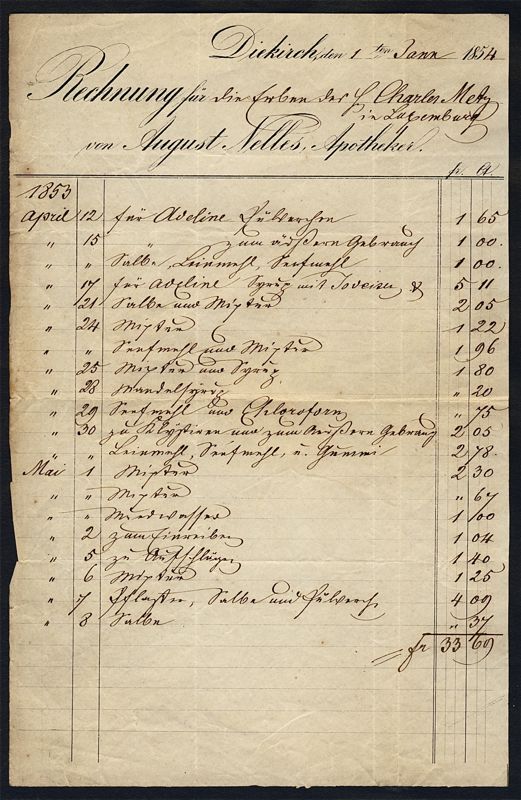|
"Chloroform, Formylchlorid, eine Verbindung des Formyls mit Chlor, wird erhalten, indem man eine Mischung von Chlorkalk, Wasser und Weingeist einer Destillation unterwirft. Das C. wird als betäubendes Mittel sowohl vor chirurg. Operationen, als in Krankheiten bei heftigen Schmerzen angewendet" (Herders Conversations-Lexikon; 1854, Bd. II, S. 96).
..... no proof so for a tracheostomy, chloroform was a painkiller and anesthetic!
1854 played in the family Charles METZ (1799-1853) from a drama: first the father, then the daughter was carried away.
"Le 23 avril 1853, en compagnie de ses deux frères [Norbert (1811-1855) and August (1812-1854)] et de ses filles, il [Charles Metz] se rendit à Diekirch auprès de sa belle-mêre où sa fille Adéline, âgée de 11 ans, était gravement malade d'une fièvre muqueuse.Le pronostic des médecins ne laissant plus aucun espoir, il eut a rupture d'anévrisme qui occasionna sa mort le lendemain, dans la maison de Vannérus.La petite adéline succomba trois semaines plus tard "(J. Mersch, Biographie nationale, 1963 tome XIII pp. 429-486).
Charles Metz died on 24 April 1853 - the aortic rupture was such a foudroyantes events that it did not come to the use of drugs. In the treatment of the daughter, however, the treating physicians must have experienced agony when administering the chloroform, since only recently the English physician John SNOW (1813-1853) described deaths:
"Remarks on the fatal case of inhalation of chloroform". London Med. Gazette, vol. 41, Feb. 18, 1848, pp. 277-278.
"On the fatal cases of inhalation of chloroform". Edinburgh Med. & Surg. Jour., Vol. 72, July 1849, pp. 75-87.
"Deaths from chloroform in Scotland." Medical Times Gazette 4 (1852): 598-99. [Ltr. to ed., June 1852]
"Death from chloroform in a case of fatty degeneration of the heart". Med. Times and Gazette, n. S. vol. 5, Oct. 9, 1852, pp. 361-362.
It was reassuring to learn that in 1853 Queen Victoria had wished for chloroform anesthesia in the delivery of her eighth child - and that she had survived both birth and anesthesia; Chloroform also proved its worth at the front, as did the British and Turkish soldiers of the Korean War (Florence Nightingale), which was raging just in these days.
The little adéline survived the chloroform but not the "fièvre muqueuse" (possibly a severe form of diphtheria). On January 1, 1854, the heirs of Metz received the bill of the Diekircher Apotheker August NELLES (1812-1913) for the medicines he had given during the sick days of the little ones. We see that the baby was ill since April 12 and was treated until May 8, with: - external use pills,
- ointment, flax flour, mustard flour,
- syrup with iodine iron,
- mixtures (not described in detail),
- rubber,
- almond syrup,
- Clysters,
- mouthwash,
- rubbings, serves, patches.
Rubber Olibani, gum Galbani and gum Myrrhae in the form of vaginal suppositories was a common remedy for adnexitis and salpingitis. Jodeisen (French iodure de fer) recorded 11 centimes at the rate of 5 francs - at that time it was the most effective remedy for the treatment of "weak, scrofulous individuals" and for arson. It was also prescribed for amenorrhoea and the white river ...
Bernhard-August NELLES was born in Kilburg in Prussia in 1812. On 10.2.1836 he was accepted in Arlon as a pharmacist. In Diekirch he took over the pharmacy of Jean-Guillaume KROMBACH in 1850, when he moved to Ettelbrück. He later transferred the officist to his son, died in 1913 in Diekirch in the respectable age of 101 years ...
|




